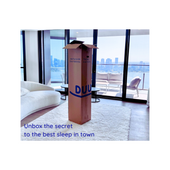Tossing and turning at night can be a frustrating experience, disrupting your sleep and leaving you feeling tired and irritable the next day.
Quality sleep is essential for overall health and well-being, and reducing nighttime restlessness can significantly improve sleep quality.
The Impact of Tossing and Turning
Tossing and turning at night can lead to fragmented sleep, making it difficult to achieve the deep, restorative sleep your body needs.
This can result in daytime fatigue, decreased cognitive function, and a weakened immune system.
Addressing the underlying causes of nighttime restlessness is crucial for improving sleep quality and overall health.
Importance of Exercise in Reducing Tossing and Turning
Regular exercise plays a significant role in promoting better sleep. P
hysical activity helps regulate the sleep-wake cycle, reduces stress and anxiety, and improves overall physical health, all of which contribute to a more restful night's sleep.
Exercise and the Sleep-Wake Cycle
The sleep-wake cycle, also known as the circadian rhythm, is a natural, internal process that regulates the sleep-wake pattern.
Exercise can help synchronise your circadian rhythm, making it easier to fall asleep and stay asleep.
Engaging in regular physical activity, especially in the morning or early afternoon, can reinforce your body's natural sleep-wake cycle.
Reducing Stress and Anxiety
Stress and anxiety are common contributors to tossing and turning at night.
Exercise has been shown to reduce levels of cortisol, the stress hormone, and increase the production of endorphins, which are natural mood elevators.
By incorporating regular exercise into your routine, you can reduce stress and anxiety, leading to more restful sleep.
Physical Health and Sleep Quality
Maintaining good physical health is essential for quality sleep.
Exercise helps improve cardiovascular health, muscle strength, and flexibility, all of which contribute to better sleep.
Active lifestyle is common in Western Australia, engaging in outdoor activities such as hiking, swimming, or cycling can provide both physical and mental benefits, promoting better sleep.
Chiropractic Insights on Reducing Tossing and Turning
Chiropractic care focuses on maintaining proper spinal alignment and overall musculoskeletal health.
From a chiropractic perspective, several factors can contribute to nighttime restlessness, including poor sleeping posture, an unsupportive mattress, and misalignments in the spine.
Proper Sleeping Posture
Maintaining proper sleeping posture is crucial for reducing tossing and turning.
Chiropractors recommend sleeping on your back or side, as these positions help maintain the natural curvature of the spine.
If you sleep on your back, placing a pillow under your knees can help reduce lower back strain.
Side sleepers should use a pillow between their knees to keep the spine aligned.
Choosing the Right Mattress and Pillow
An unsupportive mattress or pillow can lead to discomfort and contribute to nighttime restlessness.
Chiropractors often recommend firm mattresses that provide adequate support for the spine.
Similarly, a pillow that supports the natural curve of the neck can prevent neck pain and improve sleep quality.
For residents of Western Australia, investing in a high-quality mattress and pillow can make a significant difference in reducing tossing and turning.
Spinal Adjustments
Chiropractic adjustments can help correct misalignments in the spine, reducing pain and discomfort that may cause tossing and turning.
Regular chiropractic care can improve overall spinal health, promoting better sleep.
If you experience persistent sleep disturbances, consulting a chiropractor in Western Australia can provide valuable insights and personalized care.
Tips for Reducing Tossing and Turning
In addition to exercise and chiropractic care, several practical tips can help reduce tossing and turning at night.
These strategies focus on creating a conducive sleep environment, establishing a consistent sleep routine, and adopting healthy sleep habits.
Create a Conducive Sleep Environment
- Comfortable Mattress and Pillow: Ensure your mattress and pillow provide adequate support and comfort. As mentioned earlier, a firm mattress and a supportive pillow can significantly improve sleep quality.
- Room Temperature: Keep your bedroom cool and comfortable. A room temperature between 15-19°C is ideal for sleep.
- Darkness: Use blackout curtains or an eye mask to block out light. Exposure to light can interfere with the production of melatonin, the sleep hormone.
- Noise: Minimize noise disturbances by using earplugs or a white noise machine.
Establish a Consistent Sleep Routine
- Regular Sleep Schedule: Go to bed and wake up at the same time every day, even on weekends. This helps regulate your circadian rhythm.
- Relaxing Bedtime Routine: Develop a calming pre-sleep routine, such as reading a book, taking a warm bath, or practicing relaxation techniques like deep breathing or meditation.
- Limit Screen Time: Avoid electronic devices, such as smartphones and tablets, at least an hour before bed. The blue light emitted by screens can interfere with melatonin production and disrupt sleep.
Adopt Healthy Sleep Habits
- Avoid Stimulants: Limit consumption of caffeine, nicotine, and alcohol, especially in the evening. These substances can interfere with your ability to fall asleep and stay asleep.
- Balanced Diet: Eat a balanced diet and avoid large meals close to bedtime. A light snack that includes protein and carbohydrates, such as a small piece of fruit with a handful of nuts, can help stabilize blood sugar levels and promote sleep.
- Hydration: Stay hydrated throughout the day, but reduce fluid intake in the evening to minimize nighttime trips to the bathroom.
Mind-Body Techniques
Incorporating mind-body techniques into your daily routine can help reduce stress and promote relaxation, leading to better sleep.
- Meditation: Practicing mindfulness meditation can help calm the mind and reduce anxiety. Apps like Headspace and Calm offer guided meditation sessions specifically designed for sleep.
- Yoga: Gentle yoga stretches before bed can help release tension in the muscles and promote relaxation. Poses such as Child's Pose, Legs Up the Wall, and Corpse Pose are particularly beneficial for sleep.
- Progressive Muscle Relaxation: This technique involves tensing and then relaxing each muscle group in the body, starting from the toes and working up to the head. It can help release physical tension and prepare the body for sleep.
Seek Professional Help
If you continue to experience tossing and turning despite implementing these strategies, it may be helpful to seek professional help.
Consult with a healthcare provider, such as a sleep specialist or chiropractor, to identify any underlying issues that may be affecting your sleep.
Tossing and turning at night can significantly impact your sleep quality and overall health.
By incorporating regular exercise, maintaining proper sleeping posture, and seeking chiropractic care, you can reduce nighttime restlessness and achieve better sleep.
Additionally, creating a conducive sleep environment, establishing a consistent sleep routine, and adopting healthy sleep habits are essential for improving sleep quality.
For people in Western Australia, prioritising sleep and addressing the underlying causes of tossing and turning can lead to a more restful, rejuvenating night's sleep.
By following these tips and seeking professional guidance when needed, you can enjoy the benefits of quality sleep and wake up feeling refreshed and ready to take on the day.

















































